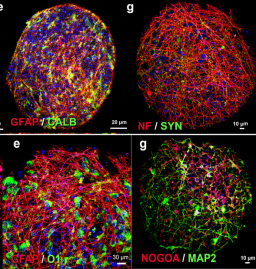David Pamies
Center for Alternatives to Animal Testing, Johns Hopkins University, Baltimore, MD, USA
Paula Barreras
Department of Neurology, Johns Hopkins University, Baltimore, MD, USA; Division of Neuroimmunology, Johns Hopkins University, Baltimore, MD, USA
Katharina Block
Division of Neuroimmunology, Johns Hopkins University, Baltimore, MD, USA
Georgia Makri
Department of Neurology, Johns Hopkins University, Baltimore, MD, USA; Institute for Cell Engineering, Johns Hopkins University, Baltimore, MD, USA
Anupama Kumar
Department of Neurology, Johns Hopkins University, Baltimore, MD, USA; Division of Neuroimmunology, Johns Hopkins University, Baltimore, MD, USA
Daphne Wiersma
Center for Alternatives to Animal Testing, Johns Hopkins University, Baltimore, MD, USA
Lena Smirnova
Center for Alternatives to Animal Testing, Johns Hopkins University, Baltimore, MD, USA
Ce Zhang
Department of Neurology, Johns Hopkins University, Baltimore, MD, USA; Institute for Cell Engineering, Johns Hopkins University, Baltimore, MD, USA
Joseph Bressler
Hugo Moser Institute at the Kennedy Krieger, Johns Hopkins University, Baltimore, MD, USA
Kimberly M. Christian
Department of Neurology, Johns Hopkins University, Baltimore, MD, USA; Institute for Cell Engineering, Johns Hopkins University, Baltimore, MD, USA
Georgina Harris
Center for Alternatives to Animal Testing, Johns Hopkins University, Baltimore, MD, USA
Guo-li Ming
Department of Neurology, Johns Hopkins University, Baltimore, MD, USA; Institute for Cell Engineering, Johns Hopkins University, Baltimore, MD, USA; The Solomon Snyder Department of Neuroscience, Johns Hopkins University, Baltimore, MD, USA
Cindy J. Berlinicke
Wilmer Eye Institute, Johns Hopkins University, Baltimore, MD, USA
Kelly Kyro
US Army Edgewood Chemical Biological Center, Aberdeen Proving Ground, MD, USA
Hongjun Song
Department of Neurology, Johns Hopkins University, Baltimore, MD, USA; Institute for Cell Engineering, Johns Hopkins University, Baltimore, MD, USA; The Solomon Snyder Department of Neuroscience, Johns Hopkins University, Baltimore, MD, USA
Carlos A. Pardo
Department of Neurology, Johns Hopkins University, Baltimore, MD, USA; Division of Neuroimmunology, Johns Hopkins University, Baltimore, MD, USA
Thomas Hartung
Center for Alternatives to Animal Testing, Johns Hopkins University, Baltimore, MD, USA; University of Konstanz, Konstanz, Germany
Helena T. Hogberg
Center for Alternatives to Animal Testing, Johns Hopkins University, Baltimore, MD, USA
[hide affiliations]
Abstract
Human in vitro models of brain neurophysiology are needed to investigate molecular and cellular mechanisms associated with neurological disorders and neurotoxicity. We have developed a reproducible iPSC-derived human 3D brain microphysiological system (BMPS), comprised of differentiated mature neurons and glial cells (astrocytes and oligodendrocytes) that reproduce neuronal-glial interactions and connectivity. BMPS mature over eight weeks and show the critical elements of neuronal function: synaptogenesis and neuron-to-neuron (e.g., spontaneous electric field potentials) and neuronal-glial interactions (e.g., myelination), which mimic the microenvironment of the central nervous system, rarely seen in vitro before. The BMPS shows 40% overall myelination after 8 weeks of differentiation. Myelin was observed by immunohistochemistry and confirmed by confocal microscopy 3D reconstruction and electron microscopy. These findings are of particular relevance since myelin is crucial for proper neuronal function and development. The ability to assess oligodendroglial function and mechanisms associated with myelination in this BMPS model provide an excellent tool for future studies of neurological disorders such as multiple sclerosis and other demyelinating diseases. The BMPS provides a suitable and reliable model to investigate neuron-neuroglia function as well as pathogenic mechanisms in neurotoxicology.


